Various Aspects of Corporate Governance for ASX Council
VerifiedAdded on 2023/06/13
|11
|2515
|120
AI Summary
This report discusses the importance of corporate governance for Australian business organizations. It examines various aspects of corporate governance such as stakeholder engagement, continuous disclosure, executive remuneration, CSR, and health and safety policies. The report recommends that ASX Council should develop an effective corporate governance framework to ensure ethical practices within businesses.
Contribute Materials
Your contribution can guide someone’s learning journey. Share your
documents today.

1
ACC30008 Accounting Theory
ACC30008 Accounting Theory
Secure Best Marks with AI Grader
Need help grading? Try our AI Grader for instant feedback on your assignments.
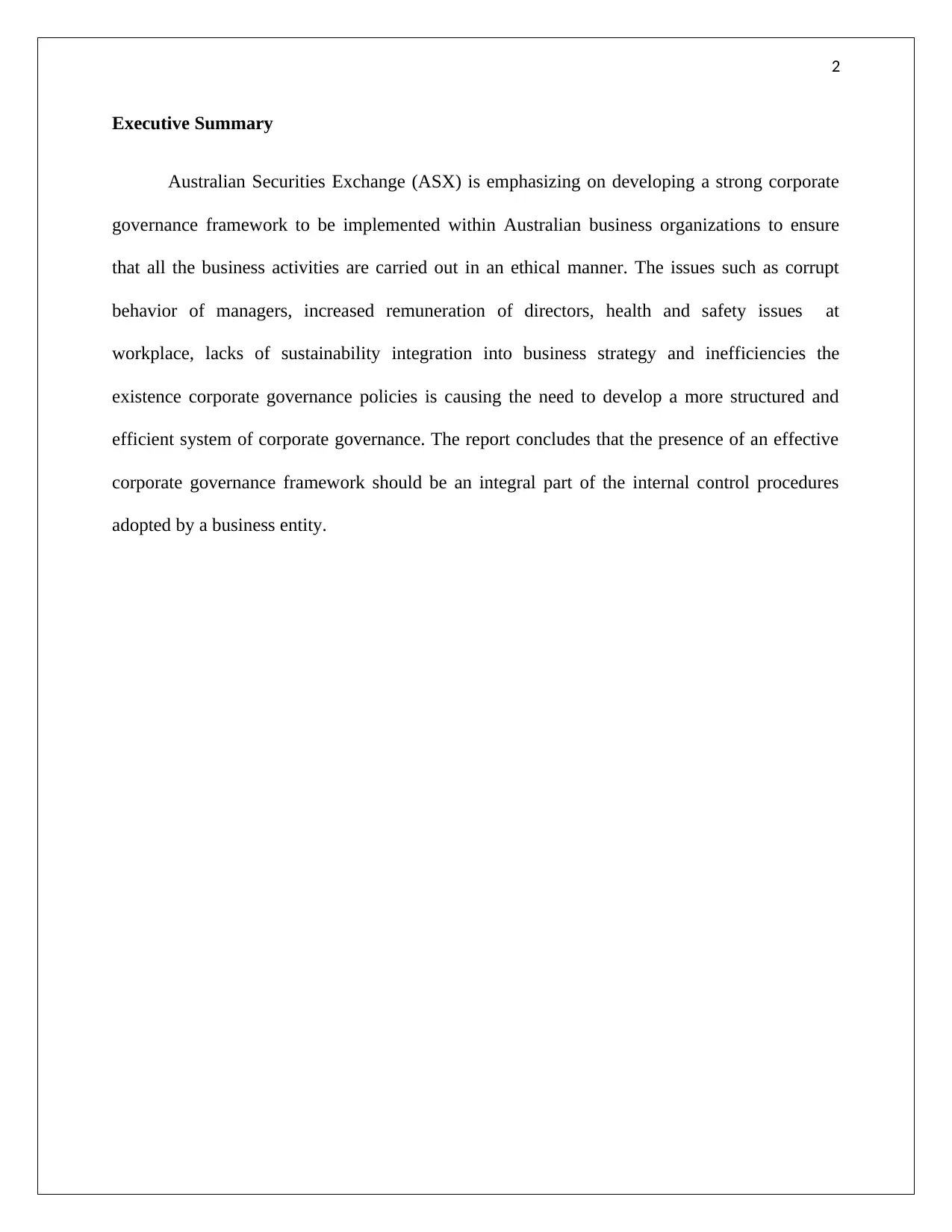
2
Executive Summary
Australian Securities Exchange (ASX) is emphasizing on developing a strong corporate
governance framework to be implemented within Australian business organizations to ensure
that all the business activities are carried out in an ethical manner. The issues such as corrupt
behavior of managers, increased remuneration of directors, health and safety issues at
workplace, lacks of sustainability integration into business strategy and inefficiencies the
existence corporate governance policies is causing the need to develop a more structured and
efficient system of corporate governance. The report concludes that the presence of an effective
corporate governance framework should be an integral part of the internal control procedures
adopted by a business entity.
Executive Summary
Australian Securities Exchange (ASX) is emphasizing on developing a strong corporate
governance framework to be implemented within Australian business organizations to ensure
that all the business activities are carried out in an ethical manner. The issues such as corrupt
behavior of managers, increased remuneration of directors, health and safety issues at
workplace, lacks of sustainability integration into business strategy and inefficiencies the
existence corporate governance policies is causing the need to develop a more structured and
efficient system of corporate governance. The report concludes that the presence of an effective
corporate governance framework should be an integral part of the internal control procedures
adopted by a business entity.
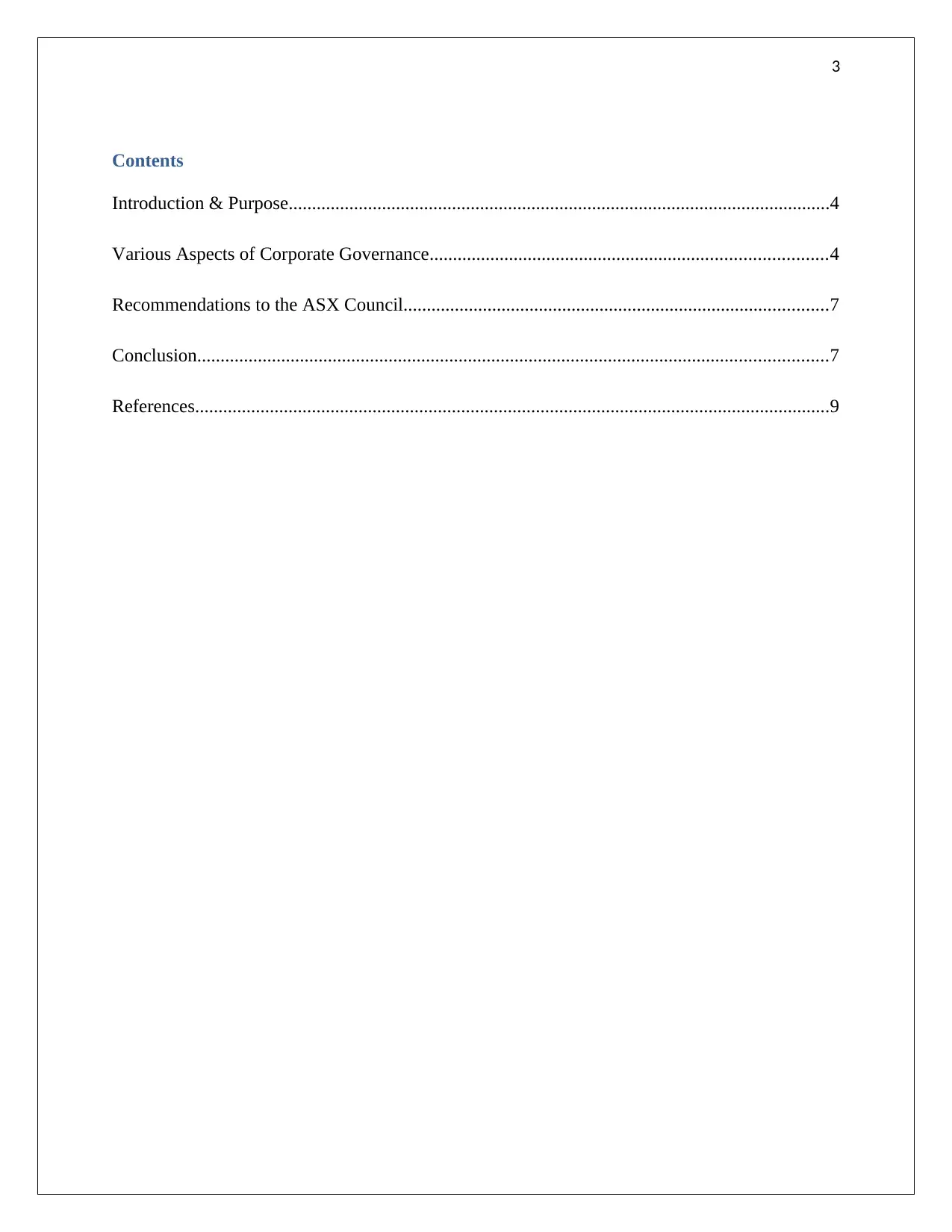
3
Contents
Introduction & Purpose....................................................................................................................4
Various Aspects of Corporate Governance.....................................................................................4
Recommendations to the ASX Council...........................................................................................7
Conclusion.......................................................................................................................................7
References........................................................................................................................................9
Contents
Introduction & Purpose....................................................................................................................4
Various Aspects of Corporate Governance.....................................................................................4
Recommendations to the ASX Council...........................................................................................7
Conclusion.......................................................................................................................................7
References........................................................................................................................................9
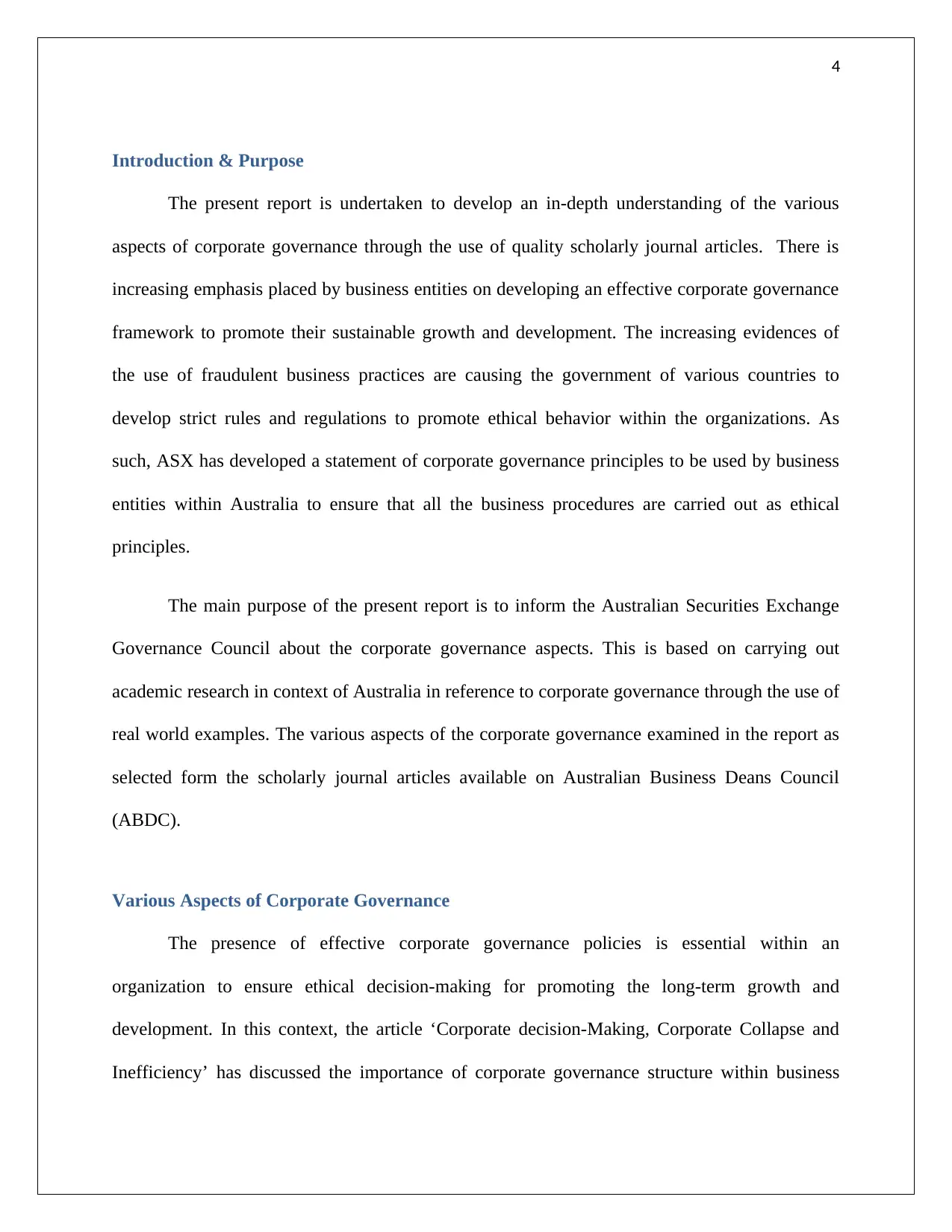
4
Introduction & Purpose
The present report is undertaken to develop an in-depth understanding of the various
aspects of corporate governance through the use of quality scholarly journal articles. There is
increasing emphasis placed by business entities on developing an effective corporate governance
framework to promote their sustainable growth and development. The increasing evidences of
the use of fraudulent business practices are causing the government of various countries to
develop strict rules and regulations to promote ethical behavior within the organizations. As
such, ASX has developed a statement of corporate governance principles to be used by business
entities within Australia to ensure that all the business procedures are carried out as ethical
principles.
The main purpose of the present report is to inform the Australian Securities Exchange
Governance Council about the corporate governance aspects. This is based on carrying out
academic research in context of Australia in reference to corporate governance through the use of
real world examples. The various aspects of the corporate governance examined in the report as
selected form the scholarly journal articles available on Australian Business Deans Council
(ABDC).
Various Aspects of Corporate Governance
The presence of effective corporate governance policies is essential within an
organization to ensure ethical decision-making for promoting the long-term growth and
development. In this context, the article ‘Corporate decision-Making, Corporate Collapse and
Inefficiency’ has discussed the importance of corporate governance structure within business
Introduction & Purpose
The present report is undertaken to develop an in-depth understanding of the various
aspects of corporate governance through the use of quality scholarly journal articles. There is
increasing emphasis placed by business entities on developing an effective corporate governance
framework to promote their sustainable growth and development. The increasing evidences of
the use of fraudulent business practices are causing the government of various countries to
develop strict rules and regulations to promote ethical behavior within the organizations. As
such, ASX has developed a statement of corporate governance principles to be used by business
entities within Australia to ensure that all the business procedures are carried out as ethical
principles.
The main purpose of the present report is to inform the Australian Securities Exchange
Governance Council about the corporate governance aspects. This is based on carrying out
academic research in context of Australia in reference to corporate governance through the use of
real world examples. The various aspects of the corporate governance examined in the report as
selected form the scholarly journal articles available on Australian Business Deans Council
(ABDC).
Various Aspects of Corporate Governance
The presence of effective corporate governance policies is essential within an
organization to ensure ethical decision-making for promoting the long-term growth and
development. In this context, the article ‘Corporate decision-Making, Corporate Collapse and
Inefficiency’ has discussed the importance of corporate governance structure within business
Secure Best Marks with AI Grader
Need help grading? Try our AI Grader for instant feedback on your assignments.
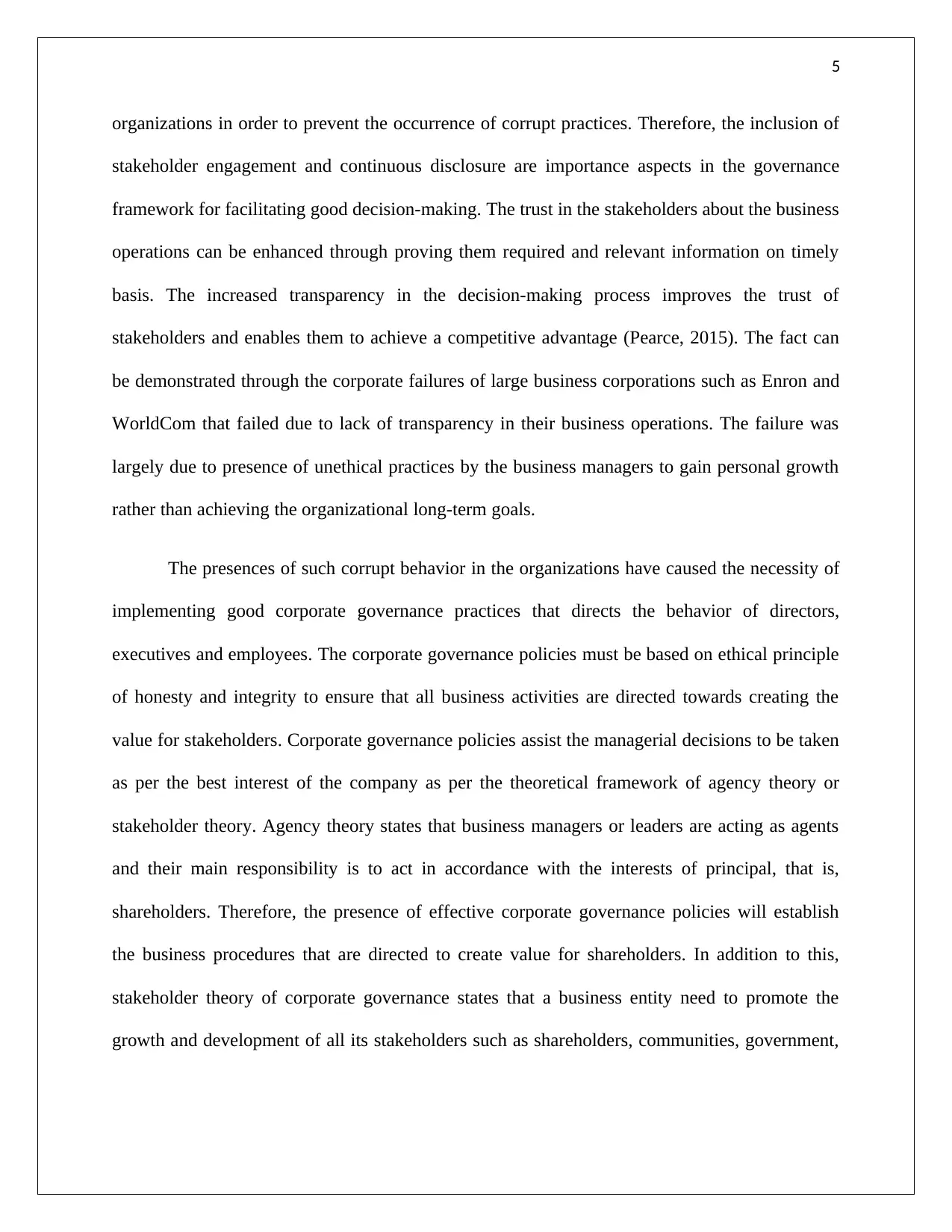
5
organizations in order to prevent the occurrence of corrupt practices. Therefore, the inclusion of
stakeholder engagement and continuous disclosure are importance aspects in the governance
framework for facilitating good decision-making. The trust in the stakeholders about the business
operations can be enhanced through proving them required and relevant information on timely
basis. The increased transparency in the decision-making process improves the trust of
stakeholders and enables them to achieve a competitive advantage (Pearce, 2015). The fact can
be demonstrated through the corporate failures of large business corporations such as Enron and
WorldCom that failed due to lack of transparency in their business operations. The failure was
largely due to presence of unethical practices by the business managers to gain personal growth
rather than achieving the organizational long-term goals.
The presences of such corrupt behavior in the organizations have caused the necessity of
implementing good corporate governance practices that directs the behavior of directors,
executives and employees. The corporate governance policies must be based on ethical principle
of honesty and integrity to ensure that all business activities are directed towards creating the
value for stakeholders. Corporate governance policies assist the managerial decisions to be taken
as per the best interest of the company as per the theoretical framework of agency theory or
stakeholder theory. Agency theory states that business managers or leaders are acting as agents
and their main responsibility is to act in accordance with the interests of principal, that is,
shareholders. Therefore, the presence of effective corporate governance policies will establish
the business procedures that are directed to create value for shareholders. In addition to this,
stakeholder theory of corporate governance states that a business entity need to promote the
growth and development of all its stakeholders such as shareholders, communities, government,
organizations in order to prevent the occurrence of corrupt practices. Therefore, the inclusion of
stakeholder engagement and continuous disclosure are importance aspects in the governance
framework for facilitating good decision-making. The trust in the stakeholders about the business
operations can be enhanced through proving them required and relevant information on timely
basis. The increased transparency in the decision-making process improves the trust of
stakeholders and enables them to achieve a competitive advantage (Pearce, 2015). The fact can
be demonstrated through the corporate failures of large business corporations such as Enron and
WorldCom that failed due to lack of transparency in their business operations. The failure was
largely due to presence of unethical practices by the business managers to gain personal growth
rather than achieving the organizational long-term goals.
The presences of such corrupt behavior in the organizations have caused the necessity of
implementing good corporate governance practices that directs the behavior of directors,
executives and employees. The corporate governance policies must be based on ethical principle
of honesty and integrity to ensure that all business activities are directed towards creating the
value for stakeholders. Corporate governance policies assist the managerial decisions to be taken
as per the best interest of the company as per the theoretical framework of agency theory or
stakeholder theory. Agency theory states that business managers or leaders are acting as agents
and their main responsibility is to act in accordance with the interests of principal, that is,
shareholders. Therefore, the presence of effective corporate governance policies will establish
the business procedures that are directed to create value for shareholders. In addition to this,
stakeholder theory of corporate governance states that a business entity need to promote the
growth and development of all its stakeholders such as shareholders, communities, government,
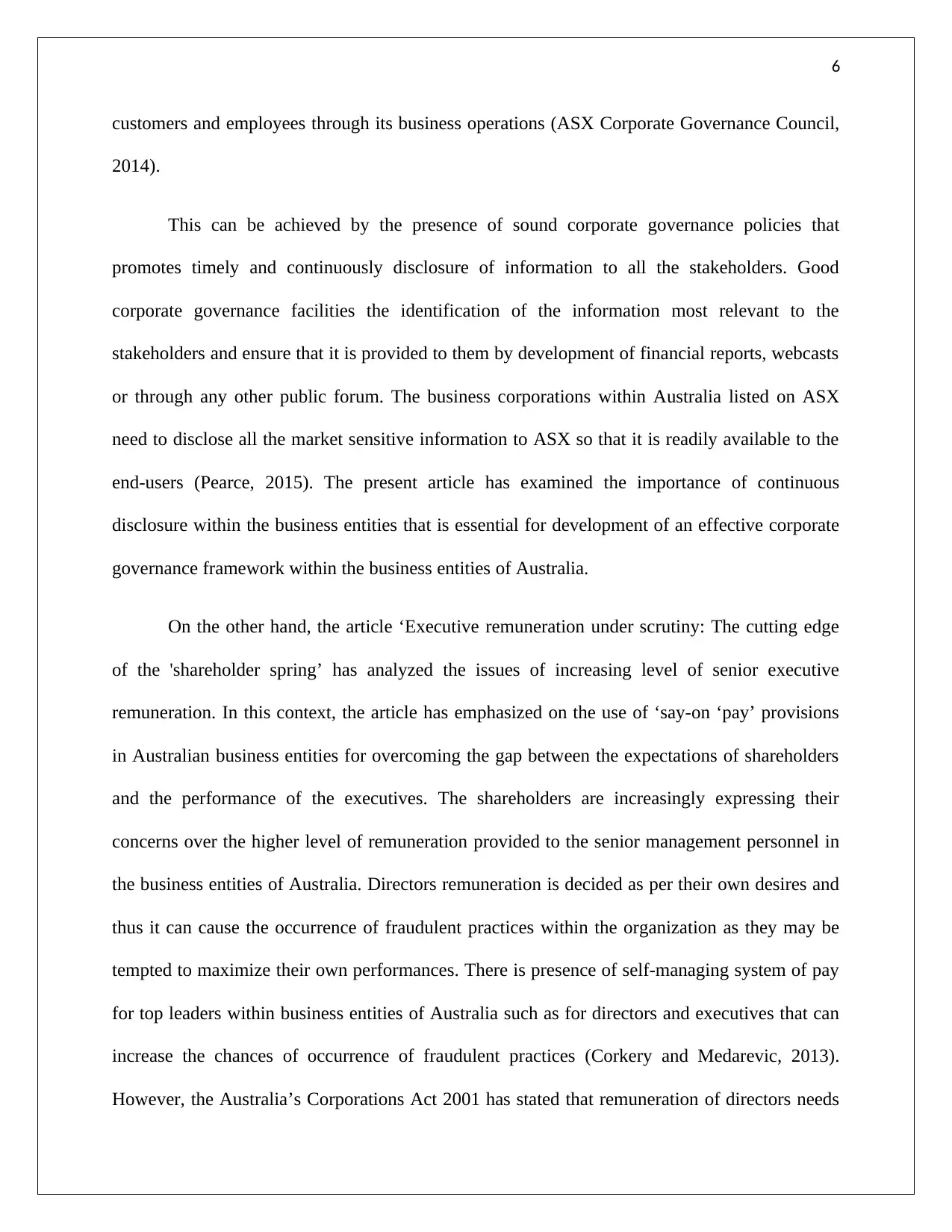
6
customers and employees through its business operations (ASX Corporate Governance Council,
2014).
This can be achieved by the presence of sound corporate governance policies that
promotes timely and continuously disclosure of information to all the stakeholders. Good
corporate governance facilities the identification of the information most relevant to the
stakeholders and ensure that it is provided to them by development of financial reports, webcasts
or through any other public forum. The business corporations within Australia listed on ASX
need to disclose all the market sensitive information to ASX so that it is readily available to the
end-users (Pearce, 2015). The present article has examined the importance of continuous
disclosure within the business entities that is essential for development of an effective corporate
governance framework within the business entities of Australia.
On the other hand, the article ‘Executive remuneration under scrutiny: The cutting edge
of the 'shareholder spring’ has analyzed the issues of increasing level of senior executive
remuneration. In this context, the article has emphasized on the use of ‘say-on ‘pay’ provisions
in Australian business entities for overcoming the gap between the expectations of shareholders
and the performance of the executives. The shareholders are increasingly expressing their
concerns over the higher level of remuneration provided to the senior management personnel in
the business entities of Australia. Directors remuneration is decided as per their own desires and
thus it can cause the occurrence of fraudulent practices within the organization as they may be
tempted to maximize their own performances. There is presence of self-managing system of pay
for top leaders within business entities of Australia such as for directors and executives that can
increase the chances of occurrence of fraudulent practices (Corkery and Medarevic, 2013).
However, the Australia’s Corporations Act 2001 has stated that remuneration of directors needs
customers and employees through its business operations (ASX Corporate Governance Council,
2014).
This can be achieved by the presence of sound corporate governance policies that
promotes timely and continuously disclosure of information to all the stakeholders. Good
corporate governance facilities the identification of the information most relevant to the
stakeholders and ensure that it is provided to them by development of financial reports, webcasts
or through any other public forum. The business corporations within Australia listed on ASX
need to disclose all the market sensitive information to ASX so that it is readily available to the
end-users (Pearce, 2015). The present article has examined the importance of continuous
disclosure within the business entities that is essential for development of an effective corporate
governance framework within the business entities of Australia.
On the other hand, the article ‘Executive remuneration under scrutiny: The cutting edge
of the 'shareholder spring’ has analyzed the issues of increasing level of senior executive
remuneration. In this context, the article has emphasized on the use of ‘say-on ‘pay’ provisions
in Australian business entities for overcoming the gap between the expectations of shareholders
and the performance of the executives. The shareholders are increasingly expressing their
concerns over the higher level of remuneration provided to the senior management personnel in
the business entities of Australia. Directors remuneration is decided as per their own desires and
thus it can cause the occurrence of fraudulent practices within the organization as they may be
tempted to maximize their own performances. There is presence of self-managing system of pay
for top leaders within business entities of Australia such as for directors and executives that can
increase the chances of occurrence of fraudulent practices (Corkery and Medarevic, 2013).
However, the Australia’s Corporations Act 2001 has stated that remuneration of directors needs
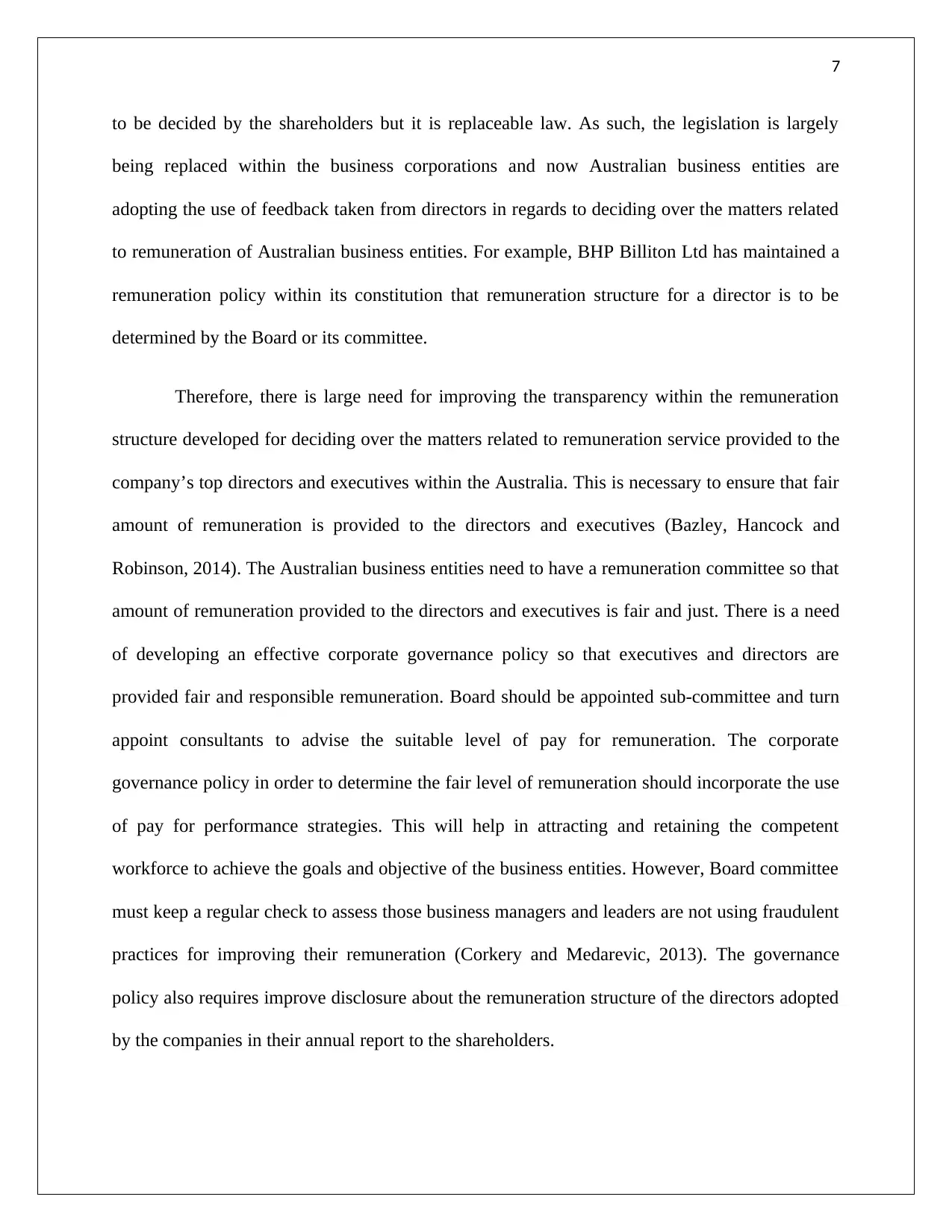
7
to be decided by the shareholders but it is replaceable law. As such, the legislation is largely
being replaced within the business corporations and now Australian business entities are
adopting the use of feedback taken from directors in regards to deciding over the matters related
to remuneration of Australian business entities. For example, BHP Billiton Ltd has maintained a
remuneration policy within its constitution that remuneration structure for a director is to be
determined by the Board or its committee.
Therefore, there is large need for improving the transparency within the remuneration
structure developed for deciding over the matters related to remuneration service provided to the
company’s top directors and executives within the Australia. This is necessary to ensure that fair
amount of remuneration is provided to the directors and executives (Bazley, Hancock and
Robinson, 2014). The Australian business entities need to have a remuneration committee so that
amount of remuneration provided to the directors and executives is fair and just. There is a need
of developing an effective corporate governance policy so that executives and directors are
provided fair and responsible remuneration. Board should be appointed sub-committee and turn
appoint consultants to advise the suitable level of pay for remuneration. The corporate
governance policy in order to determine the fair level of remuneration should incorporate the use
of pay for performance strategies. This will help in attracting and retaining the competent
workforce to achieve the goals and objective of the business entities. However, Board committee
must keep a regular check to assess those business managers and leaders are not using fraudulent
practices for improving their remuneration (Corkery and Medarevic, 2013). The governance
policy also requires improve disclosure about the remuneration structure of the directors adopted
by the companies in their annual report to the shareholders.
to be decided by the shareholders but it is replaceable law. As such, the legislation is largely
being replaced within the business corporations and now Australian business entities are
adopting the use of feedback taken from directors in regards to deciding over the matters related
to remuneration of Australian business entities. For example, BHP Billiton Ltd has maintained a
remuneration policy within its constitution that remuneration structure for a director is to be
determined by the Board or its committee.
Therefore, there is large need for improving the transparency within the remuneration
structure developed for deciding over the matters related to remuneration service provided to the
company’s top directors and executives within the Australia. This is necessary to ensure that fair
amount of remuneration is provided to the directors and executives (Bazley, Hancock and
Robinson, 2014). The Australian business entities need to have a remuneration committee so that
amount of remuneration provided to the directors and executives is fair and just. There is a need
of developing an effective corporate governance policy so that executives and directors are
provided fair and responsible remuneration. Board should be appointed sub-committee and turn
appoint consultants to advise the suitable level of pay for remuneration. The corporate
governance policy in order to determine the fair level of remuneration should incorporate the use
of pay for performance strategies. This will help in attracting and retaining the competent
workforce to achieve the goals and objective of the business entities. However, Board committee
must keep a regular check to assess those business managers and leaders are not using fraudulent
practices for improving their remuneration (Corkery and Medarevic, 2013). The governance
policy also requires improve disclosure about the remuneration structure of the directors adopted
by the companies in their annual report to the shareholders.
Paraphrase This Document
Need a fresh take? Get an instant paraphrase of this document with our AI Paraphraser
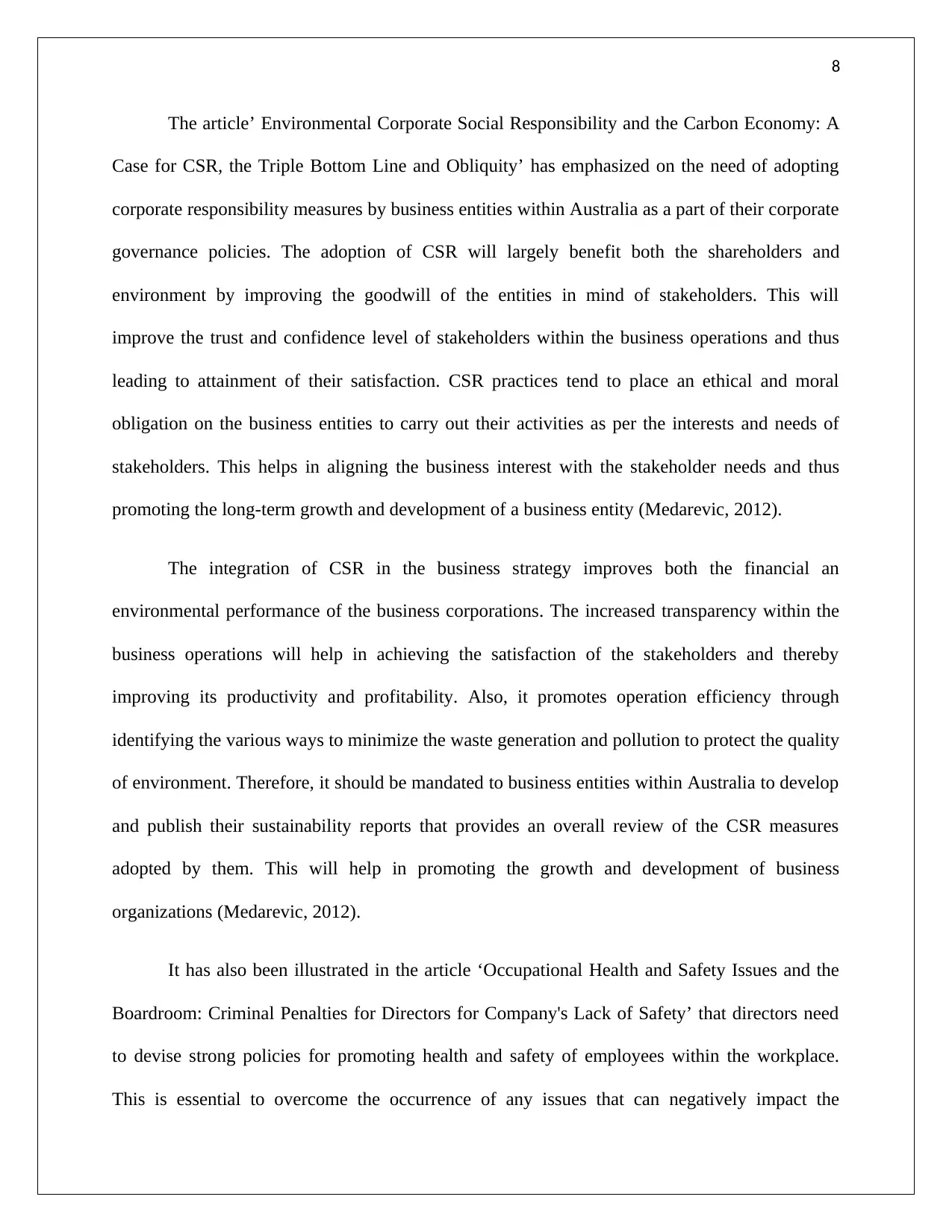
8
The article’ Environmental Corporate Social Responsibility and the Carbon Economy: A
Case for CSR, the Triple Bottom Line and Obliquity’ has emphasized on the need of adopting
corporate responsibility measures by business entities within Australia as a part of their corporate
governance policies. The adoption of CSR will largely benefit both the shareholders and
environment by improving the goodwill of the entities in mind of stakeholders. This will
improve the trust and confidence level of stakeholders within the business operations and thus
leading to attainment of their satisfaction. CSR practices tend to place an ethical and moral
obligation on the business entities to carry out their activities as per the interests and needs of
stakeholders. This helps in aligning the business interest with the stakeholder needs and thus
promoting the long-term growth and development of a business entity (Medarevic, 2012).
The integration of CSR in the business strategy improves both the financial an
environmental performance of the business corporations. The increased transparency within the
business operations will help in achieving the satisfaction of the stakeholders and thereby
improving its productivity and profitability. Also, it promotes operation efficiency through
identifying the various ways to minimize the waste generation and pollution to protect the quality
of environment. Therefore, it should be mandated to business entities within Australia to develop
and publish their sustainability reports that provides an overall review of the CSR measures
adopted by them. This will help in promoting the growth and development of business
organizations (Medarevic, 2012).
It has also been illustrated in the article ‘Occupational Health and Safety Issues and the
Boardroom: Criminal Penalties for Directors for Company's Lack of Safety’ that directors need
to devise strong policies for promoting health and safety of employees within the workplace.
This is essential to overcome the occurrence of any issues that can negatively impact the
The article’ Environmental Corporate Social Responsibility and the Carbon Economy: A
Case for CSR, the Triple Bottom Line and Obliquity’ has emphasized on the need of adopting
corporate responsibility measures by business entities within Australia as a part of their corporate
governance policies. The adoption of CSR will largely benefit both the shareholders and
environment by improving the goodwill of the entities in mind of stakeholders. This will
improve the trust and confidence level of stakeholders within the business operations and thus
leading to attainment of their satisfaction. CSR practices tend to place an ethical and moral
obligation on the business entities to carry out their activities as per the interests and needs of
stakeholders. This helps in aligning the business interest with the stakeholder needs and thus
promoting the long-term growth and development of a business entity (Medarevic, 2012).
The integration of CSR in the business strategy improves both the financial an
environmental performance of the business corporations. The increased transparency within the
business operations will help in achieving the satisfaction of the stakeholders and thereby
improving its productivity and profitability. Also, it promotes operation efficiency through
identifying the various ways to minimize the waste generation and pollution to protect the quality
of environment. Therefore, it should be mandated to business entities within Australia to develop
and publish their sustainability reports that provides an overall review of the CSR measures
adopted by them. This will help in promoting the growth and development of business
organizations (Medarevic, 2012).
It has also been illustrated in the article ‘Occupational Health and Safety Issues and the
Boardroom: Criminal Penalties for Directors for Company's Lack of Safety’ that directors need
to devise strong policies for promoting health and safety of employees within the workplace.
This is essential to overcome the occurrence of any issues that can negatively impact the
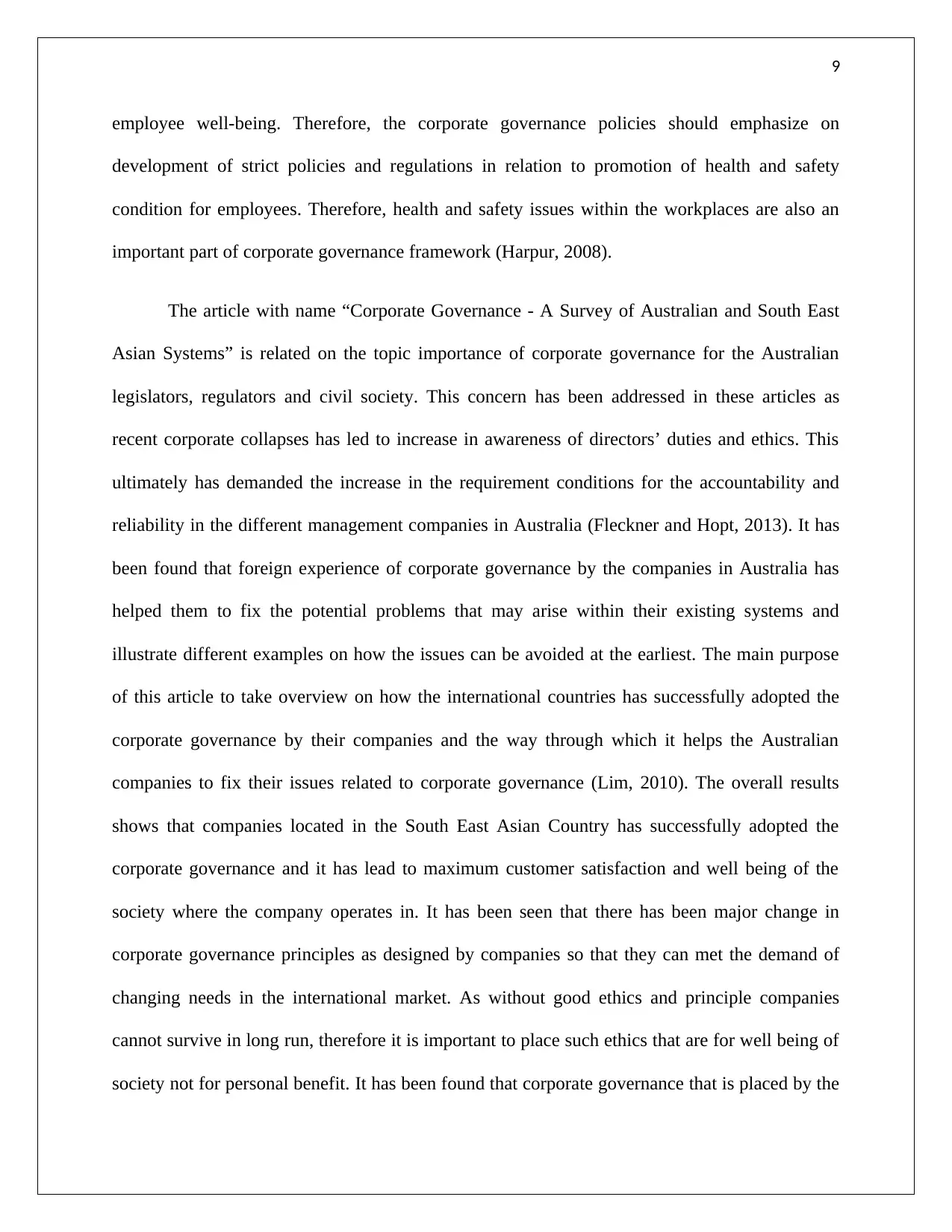
9
employee well-being. Therefore, the corporate governance policies should emphasize on
development of strict policies and regulations in relation to promotion of health and safety
condition for employees. Therefore, health and safety issues within the workplaces are also an
important part of corporate governance framework (Harpur, 2008).
The article with name “Corporate Governance - A Survey of Australian and South East
Asian Systems” is related on the topic importance of corporate governance for the Australian
legislators, regulators and civil society. This concern has been addressed in these articles as
recent corporate collapses has led to increase in awareness of directors’ duties and ethics. This
ultimately has demanded the increase in the requirement conditions for the accountability and
reliability in the different management companies in Australia (Fleckner and Hopt, 2013). It has
been found that foreign experience of corporate governance by the companies in Australia has
helped them to fix the potential problems that may arise within their existing systems and
illustrate different examples on how the issues can be avoided at the earliest. The main purpose
of this article to take overview on how the international countries has successfully adopted the
corporate governance by their companies and the way through which it helps the Australian
companies to fix their issues related to corporate governance (Lim, 2010). The overall results
shows that companies located in the South East Asian Country has successfully adopted the
corporate governance and it has lead to maximum customer satisfaction and well being of the
society where the company operates in. It has been seen that there has been major change in
corporate governance principles as designed by companies so that they can met the demand of
changing needs in the international market. As without good ethics and principle companies
cannot survive in long run, therefore it is important to place such ethics that are for well being of
society not for personal benefit. It has been found that corporate governance that is placed by the
employee well-being. Therefore, the corporate governance policies should emphasize on
development of strict policies and regulations in relation to promotion of health and safety
condition for employees. Therefore, health and safety issues within the workplaces are also an
important part of corporate governance framework (Harpur, 2008).
The article with name “Corporate Governance - A Survey of Australian and South East
Asian Systems” is related on the topic importance of corporate governance for the Australian
legislators, regulators and civil society. This concern has been addressed in these articles as
recent corporate collapses has led to increase in awareness of directors’ duties and ethics. This
ultimately has demanded the increase in the requirement conditions for the accountability and
reliability in the different management companies in Australia (Fleckner and Hopt, 2013). It has
been found that foreign experience of corporate governance by the companies in Australia has
helped them to fix the potential problems that may arise within their existing systems and
illustrate different examples on how the issues can be avoided at the earliest. The main purpose
of this article to take overview on how the international countries has successfully adopted the
corporate governance by their companies and the way through which it helps the Australian
companies to fix their issues related to corporate governance (Lim, 2010). The overall results
shows that companies located in the South East Asian Country has successfully adopted the
corporate governance and it has lead to maximum customer satisfaction and well being of the
society where the company operates in. It has been seen that there has been major change in
corporate governance principles as designed by companies so that they can met the demand of
changing needs in the international market. As without good ethics and principle companies
cannot survive in long run, therefore it is important to place such ethics that are for well being of
society not for personal benefit. It has been found that corporate governance that is placed by the
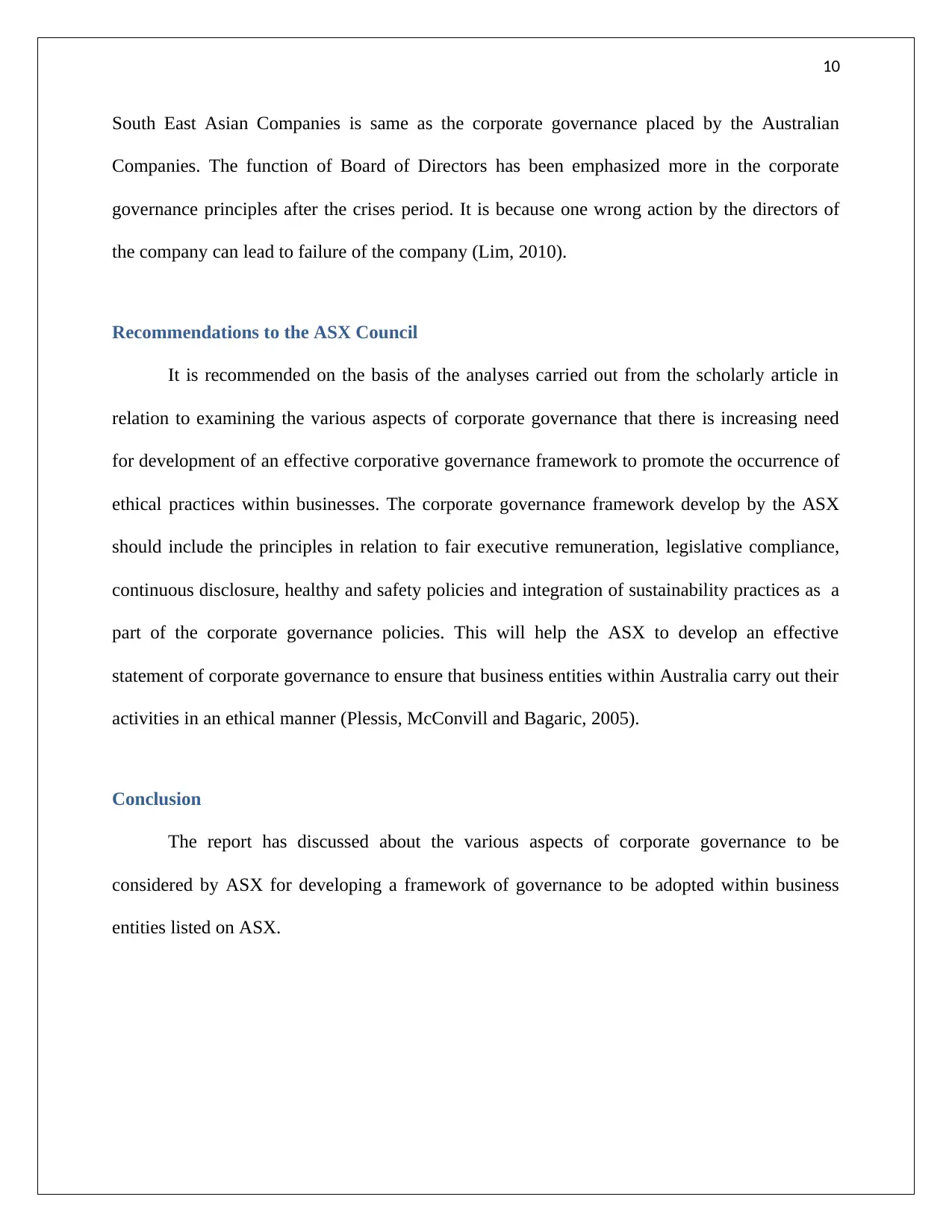
10
South East Asian Companies is same as the corporate governance placed by the Australian
Companies. The function of Board of Directors has been emphasized more in the corporate
governance principles after the crises period. It is because one wrong action by the directors of
the company can lead to failure of the company (Lim, 2010).
Recommendations to the ASX Council
It is recommended on the basis of the analyses carried out from the scholarly article in
relation to examining the various aspects of corporate governance that there is increasing need
for development of an effective corporative governance framework to promote the occurrence of
ethical practices within businesses. The corporate governance framework develop by the ASX
should include the principles in relation to fair executive remuneration, legislative compliance,
continuous disclosure, healthy and safety policies and integration of sustainability practices as a
part of the corporate governance policies. This will help the ASX to develop an effective
statement of corporate governance to ensure that business entities within Australia carry out their
activities in an ethical manner (Plessis, McConvill and Bagaric, 2005).
Conclusion
The report has discussed about the various aspects of corporate governance to be
considered by ASX for developing a framework of governance to be adopted within business
entities listed on ASX.
South East Asian Companies is same as the corporate governance placed by the Australian
Companies. The function of Board of Directors has been emphasized more in the corporate
governance principles after the crises period. It is because one wrong action by the directors of
the company can lead to failure of the company (Lim, 2010).
Recommendations to the ASX Council
It is recommended on the basis of the analyses carried out from the scholarly article in
relation to examining the various aspects of corporate governance that there is increasing need
for development of an effective corporative governance framework to promote the occurrence of
ethical practices within businesses. The corporate governance framework develop by the ASX
should include the principles in relation to fair executive remuneration, legislative compliance,
continuous disclosure, healthy and safety policies and integration of sustainability practices as a
part of the corporate governance policies. This will help the ASX to develop an effective
statement of corporate governance to ensure that business entities within Australia carry out their
activities in an ethical manner (Plessis, McConvill and Bagaric, 2005).
Conclusion
The report has discussed about the various aspects of corporate governance to be
considered by ASX for developing a framework of governance to be adopted within business
entities listed on ASX.
Secure Best Marks with AI Grader
Need help grading? Try our AI Grader for instant feedback on your assignments.
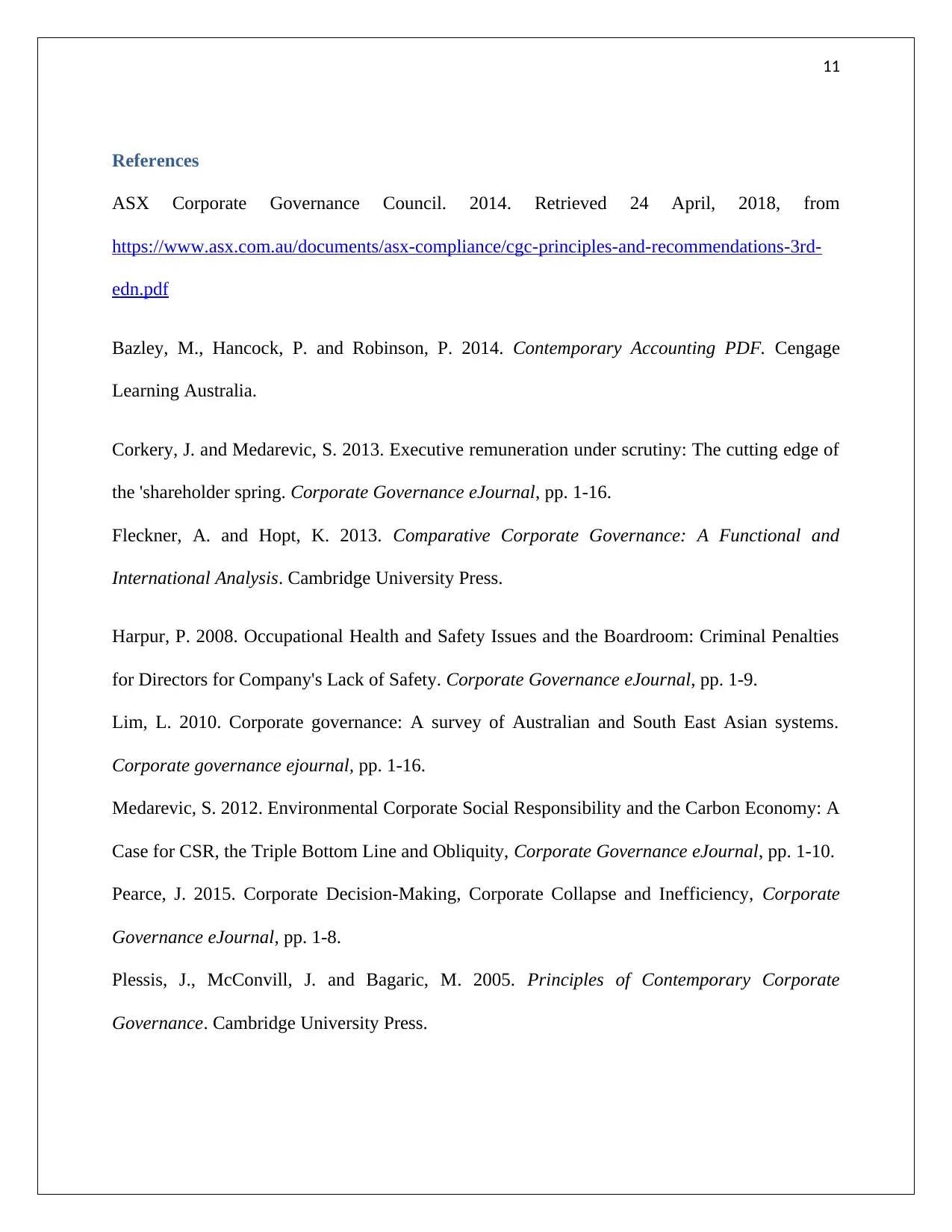
11
References
ASX Corporate Governance Council. 2014. Retrieved 24 April, 2018, from
https://www.asx.com.au/documents/asx-compliance/cgc-principles-and-recommendations-3rd-
edn.pdf
Bazley, M., Hancock, P. and Robinson, P. 2014. Contemporary Accounting PDF. Cengage
Learning Australia.
Corkery, J. and Medarevic, S. 2013. Executive remuneration under scrutiny: The cutting edge of
the 'shareholder spring. Corporate Governance eJournal, pp. 1-16.
Fleckner, A. and Hopt, K. 2013. Comparative Corporate Governance: A Functional and
International Analysis. Cambridge University Press.
Harpur, P. 2008. Occupational Health and Safety Issues and the Boardroom: Criminal Penalties
for Directors for Company's Lack of Safety. Corporate Governance eJournal, pp. 1-9.
Lim, L. 2010. Corporate governance: A survey of Australian and South East Asian systems.
Corporate governance ejournal, pp. 1-16.
Medarevic, S. 2012. Environmental Corporate Social Responsibility and the Carbon Economy: A
Case for CSR, the Triple Bottom Line and Obliquity, Corporate Governance eJournal, pp. 1-10.
Pearce, J. 2015. Corporate Decision-Making, Corporate Collapse and Inefficiency, Corporate
Governance eJournal, pp. 1-8.
Plessis, J., McConvill, J. and Bagaric, M. 2005. Principles of Contemporary Corporate
Governance. Cambridge University Press.
References
ASX Corporate Governance Council. 2014. Retrieved 24 April, 2018, from
https://www.asx.com.au/documents/asx-compliance/cgc-principles-and-recommendations-3rd-
edn.pdf
Bazley, M., Hancock, P. and Robinson, P. 2014. Contemporary Accounting PDF. Cengage
Learning Australia.
Corkery, J. and Medarevic, S. 2013. Executive remuneration under scrutiny: The cutting edge of
the 'shareholder spring. Corporate Governance eJournal, pp. 1-16.
Fleckner, A. and Hopt, K. 2013. Comparative Corporate Governance: A Functional and
International Analysis. Cambridge University Press.
Harpur, P. 2008. Occupational Health and Safety Issues and the Boardroom: Criminal Penalties
for Directors for Company's Lack of Safety. Corporate Governance eJournal, pp. 1-9.
Lim, L. 2010. Corporate governance: A survey of Australian and South East Asian systems.
Corporate governance ejournal, pp. 1-16.
Medarevic, S. 2012. Environmental Corporate Social Responsibility and the Carbon Economy: A
Case for CSR, the Triple Bottom Line and Obliquity, Corporate Governance eJournal, pp. 1-10.
Pearce, J. 2015. Corporate Decision-Making, Corporate Collapse and Inefficiency, Corporate
Governance eJournal, pp. 1-8.
Plessis, J., McConvill, J. and Bagaric, M. 2005. Principles of Contemporary Corporate
Governance. Cambridge University Press.
1 out of 11
Related Documents
Your All-in-One AI-Powered Toolkit for Academic Success.
+13062052269
info@desklib.com
Available 24*7 on WhatsApp / Email
![[object Object]](/_next/static/media/star-bottom.7253800d.svg)
Unlock your academic potential
© 2024 | Zucol Services PVT LTD | All rights reserved.



